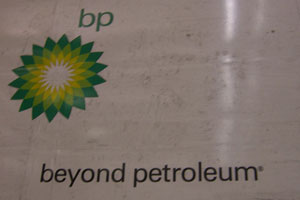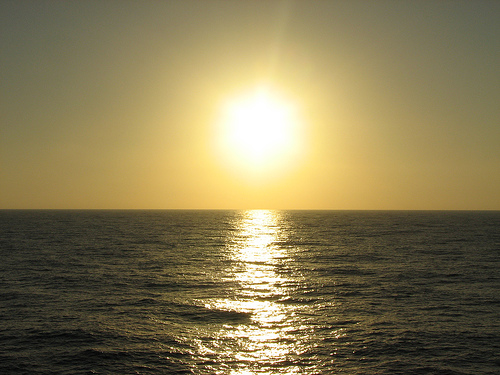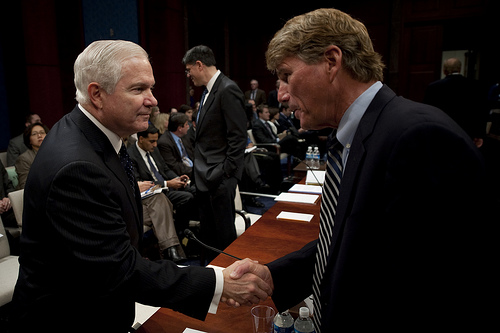
Flickr/<a href="http://www.flickr.com/photos/iaintait/69360123/">Iain Tait</a> (<a href="http://www.creativecommons.org">Creative Commons</a>).
For the last decade, BP has been busily engaged in a multi-million-dollar greenwashing campaign. Changing its name from British Petroleum to BP, the company adopted a new slogan, “Beyond Petroleum,” and began a “rebranding” effort to depict itself as a public-spirited, environmentally sensitive, green energy enterprise, the very model of 21st century corporate responsibility.
It’s going to take more than a name change and a clever ad campaign to erase the image of oil spreading across the Gulf Coast from BP’s offshore rig, and dead wildlife washing up onto beaches. Even as the company magnanimously agreed to cover the costs of cleaning up the mammoth spill, BP on Monday was still insisting that it wasn’t at fault for the accident that caused it—instead blaming the offshore drilling contractor that operated the rig. So much for corporate accountability.
Before the Deepwater Horizon disaster, BP’s green image was nothing more than a scam. While making miniscule investments in things like solar power, biofuels, and carbon fuel cells that backed its PR claims, BP continued to work relentlessly to expand its oil and gas operations. In the last decade, as the world’s second largest producer of fossil fuels, the company drilled (and spilled) vast quantities of oil and gas on Alaska’s North Slope and in the North Sea. It positioned itself to rip up Canada’s tar sands to extract its dirty oil, and grabbed a 50 percent interest in Iraq’s rich Rumaila oil field. BP boasted the highest number of explosions and other accidents at its US refineries (several of them deadly), and made the Multinational Monitor’s 10 Worst Companies lists in 2000 and 2005, based on its environmental and human rights record.
BP clearly believed that green was in the eye of the beholder. The company’s move toward green marketing began in 1997, when it quit the industry’s climate change denial group, the Global Climate Coalition, and acknowledged a possible link between global warming and the use of fossil fuels. By 2000, the vertically integrated multinational—which explores, extracts, transports, refines, and sell fuels through its myriad gas stations–had bought up Amoco, Arco, and Burmah Castrol. It united them under the BP brand with a feel-good flowering sun logo, and hired the advertising firm of Ogilvy & Mathers to launch a $200 million rebranding campaign.
As Ogilvy executive John Seifert described it in 2002, then BP CEO John Browne—or, to use his full title, Lord Browne of Madingley–”came to me with a dream proposal. He said, ‘I want this company to be a force for good in this world. Build that image and I will hold the company accountable to it.'” The problem, Seifert said, was, “No other industry is more loathed and distrusted by the public than the energy industry, and yet no other industry is more critical to modern survival. The reality is that no matter how much consumers resent energy companies, they still drive their cars and leave on the lights and turn the other cheek.” His solution was a campaign that “bridges the us/them barrier, that brings the consumer into the debate so that we can address the problem together.”
By 2004, BP was running its “BP on the Street” nationwide ad campaign, featuring what one BP executive described to Adweek as “a radical conversation with consumers about the paradox of the need for energy and the cost for getting it.” TV spots showed ordinary looking people being asked questions like, “What would you rather have, a car or a cleaner environment?” Says one woman, “I can’t imagine being without my car. But that compromise is very hard to make where we are.” Then the punch line flashes on the screen: “We voluntarily introduced cleaner fuels, six years before EPA mandates….These low-sulphur fuels reduce ozone pollution….It’s a start.” Whew. Thank goodness for BP, saving us from making those tough choices between preserving the polar ice caps and taking the bus.
Other ads had the appearance of being hard-hitting—including one that asked people what they would like to say to oil company executives. “Think about your children,” one woman says. “They’re breathing the air I’m breathing, that you’re breathing, and it’s bad. And down the line, they will suffer. And you know, think about that. You know, if you have alternatives, invest the money in alternatives. You’ll still make money. It won’t make you a Communist. It’’ll just make you a better human being.” The television and print ads always ended with a plug for BP as “a global leader” in clean energy production.
Accompanying the ad campaign was a series of public pronouncements from Lord Browne, who had been dubbed the “sun king” and the “green oilman,” and was also reputed to be Tony Blair’s favorite businessman. Browne announced a plan to reduce company-wide greenhouse gas emissions, and another to invest $8 billion in alternative energy and greenhouse gas abatement projects—an impressive figure that was actually a pittance relative to BP’s overall budget.
The gimmicks appeared to work. In 2001, BP had already been chosen as the “company that does most to protect the environment” in a survey by the Financial Times that polled not only corporate executives but also activist groups and the media. “There appears to be near consensus,” the paper reported, that BP”“has made exceptional efforts to replenish environmental resources, develop alternative fuels and communicate with stakeholders.” As for the general public, a 2007 “green brands survey” found that BP was perceived as more green than any of the other petroleum companies, and also headed the list of companies that had “become more green” in the previous five years.
And what else was going on at BP while it was supposed to be “becoming more green”?
- In 2004, BP engaged in a “massive manipulation” of the US propane market. The Commodity Futures Trading Commission later ordered the company to pay $303 million in criminal penalties and restitution to victims of its trading abuses.
- In 2005, a devastating explosion and fire at a BP refinery in Texas BP killed 15 workers and injured 170 others. In 2007, BP was fined $50 million for environmental damage caused by the refinery blast. In 2009, the Occupational Safety and Health Administration levied an additional fine of $87 million fine–the largest in OSHA’s history–for the company’s “failure to correct potential hazards faced by employees.”
- In 2006, more than 260,000 gallons of crude poured onto the Arctic tundra from a BP pipeline near Prudhoe Bay—the worst onshore spill in Alaskan history. Whistleblowers had already revealed that BP ignored warnings about leaking and corroded pipelines and had tried to cover up earlier, smaller spills, and Congressional investigations found that negligence and cost-cutting were factors in the 2006 disaster. BP was fined more than $20 million.
- In October 2007, the U.S. Minerals Management Service fined BP for a series of violations related to a near-blowout at an offshore rig in 2002. The violations included inadequate training of BP workers in “well control.”
During the period that all of these human and environmental catastrophes were going on, BP sales rose from $192 billion in 2004 to $240 billion in 2005, and then to $266 billion in 2006. The company’s profits fell in 2007 following the disasters and fines, but began rebounding as soon as BP announced massive layoffs. The dapper Lord Browne of Madingley, however, resigned after reports faulted his leadership in contributing to the accidents—and after he was found to have lied to a court about his relationship with a former male escort.
BP’s new CEO, Tony Hayward, had been head of exploration and production for BP since 2003. According to the New York Times, Hayward “promised to refocus the company and change the culture, emphasizing safety.” In the last few years, BP has spent less time promoting itself as a green company and more time depicting itself as safe, competent, and forward-thinking—a claim that has now proven more preposterous than the greenwashing was.
The Times article remarked that for Hayward, “the accident threatens to overshadow all of the efforts he has made to burnish the tattered reputation of the company.” In a meeting with BP executives in London following the spill, Hayward reportedly asked, “What the hell did we do to deserve this?”
Tony Hayward himself has the answer, since according to the Times, “he also expanded the company’s already aggressive exploratory efforts in the deep waters of the gulf.” In fact, the newspaper reported “last year, the same platform that has now sunk to the sea floor drilled the deepest well in history, opening one of the largest new fields in the world.” New information is emerging every day on the many ways in which BP cut corners when it came to safeguards on the rig—some of them implicated in the current disaster. (See Kate Sheppard’s piece for details.)
Hayward received a 40 percent pay increase in 2009 based on BP’s “improved performance.” And the company recently announced earnings of $5.6 billion for the first quarter of 2010, more than double the same quarter last year. The disaster in the Gulf, of course, has not been good for BP’s share prices. But a Morningstar oil stock analyst blithely told the New York Times that the worst oil spill in U.S. history “will test Tony and his ability to respond to this situation.” She confidently concluded, “Certainly, BP will survive this.”
Whether the Gulf Coast will survive it is another question.













